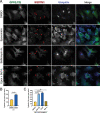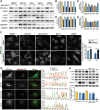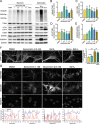Proteasomal inhibition preferentially stimulates lysosome activity relative to autophagic flux in primary astrocytes
- PMID: 35722992
- PMCID: PMC9851260
- DOI: 10.1080/15548627.2022.2084884
Proteasomal inhibition preferentially stimulates lysosome activity relative to autophagic flux in primary astrocytes
Abstract
Neurons and astrocytes face unique demands on their proteome to enable proper function and survival of the nervous system. Consequently, both cell types are critically dependent on robust quality control pathways such as macroautophagy (hereafter referred to as autophagy) and the ubiquitin-proteasome system (UPS). We previously reported that autophagy is differentially regulated in astrocytes and neurons in the context of metabolic stress, but less is understood in the context of proteotoxic stress induced by inhibition of the UPS. Dysfunction of the proteasome or autophagy has been linked to the progression of various neurodegenerative diseases. Therefore, in this study, we explored the connection between autophagy and the proteasome in primary astrocytes and neurons. Prior studies largely in non-neural models report a compensatory relationship whereby inhibition of the UPS stimulates autophagy. To our surprise, inhibition of the proteasome did not robustly upregulate autophagy in astrocytes or neurons. In fact, the effects on autophagy are modest particularly in comparison to paradigms of metabolic stress. Rather, we find that UPS inhibition in astrocytes induces formation of Ub-positive aggregates that harbor the selective autophagy receptor, SQSTM1/p62, but these structures were not productive substrates for autophagy. By contrast, we observed a significant increase in lysosomal degradation in astrocytes in response to UPS inhibition, but this stimulation was not sufficient to reduce total SQSTM1 levels. Last, UPS inhibition was more toxic in neurons compared to astrocytes, suggesting a cell type-specific vulnerability to proteotoxic stress.Abbreviations: Baf A1: bafilomycin A1; CQ: chloroquine; Epox: epoxomicin; MAP1LC3/LC3: microtubule-associated protein 1 light chain 3; MTOR: mechanistic target of rapamycin kinase; p-ULK1: phospho-ULK1; SQSTM1/p62: sequestosome 1; Ub: ubiquitin; ULK1: unc-51 like kinase 1; UPS: ubiquitin-proteasome system.
Keywords: Astrocytes; LC3; SQSTM1; autophagy; lysosomes; neurons; proteasome; ubiquitin.
Conflict of interest statement
The authors declare no conflict of interest. .
Figures











Similar articles
-
Differential regulation of autophagy during metabolic stress in astrocytes and neurons.Autophagy. 2020 Sep;16(9):1651-1667. doi: 10.1080/15548627.2019.1703354. Epub 2019 Dec 26. Autophagy. 2020. PMID: 31876243 Free PMC article.
-
The GST-BHMT assay reveals a distinct mechanism underlying proteasome inhibition-induced macroautophagy in mammalian cells.Autophagy. 2015;11(5):812-32. doi: 10.1080/15548627.2015.1034402. Autophagy. 2015. PMID: 25984893 Free PMC article.
-
Inhibition of the SEC61 translocon by mycolactone induces a protective autophagic response controlled by EIF2S1-dependent translation that does not require ULK1 activity.Autophagy. 2022 Apr;18(4):841-859. doi: 10.1080/15548627.2021.1961067. Epub 2021 Aug 23. Autophagy. 2022. PMID: 34424124 Free PMC article.
-
p62-mediated phase separation at the intersection of the ubiquitin-proteasome system and autophagy.J Cell Sci. 2018 Oct 4;131(19):jcs214304. doi: 10.1242/jcs.214304. J Cell Sci. 2018. PMID: 30287680 Free PMC article. Review.
-
The exploitation of host autophagy and ubiquitin machinery by Mycobacterium tuberculosis in shaping immune responses and host defense during infection.Autophagy. 2023 Jan;19(1):3-23. doi: 10.1080/15548627.2021.2021495. Epub 2022 Jan 9. Autophagy. 2023. PMID: 35000542 Free PMC article. Review.
Cited by
-
Research progress on astrocyte autophagy in ischemic stroke.Front Neurol. 2022 Aug 30;13:951536. doi: 10.3389/fneur.2022.951536. eCollection 2022. Front Neurol. 2022. PMID: 36110390 Free PMC article. Review.
-
Interaction between autophagy and the NLRP3 inflammasome in Alzheimer's and Parkinson's disease.Front Aging Neurosci. 2022 Oct 3;14:1018848. doi: 10.3389/fnagi.2022.1018848. eCollection 2022. Front Aging Neurosci. 2022. PMID: 36262883 Free PMC article. Review.
-
Molecular cascade reveals sequential milestones underlying hippocampal neural stem cell development into an adult state.Cell Rep. 2024 Jun 25;43(6):114339. doi: 10.1016/j.celrep.2024.114339. Epub 2024 Jun 8. Cell Rep. 2024. PMID: 38852158 Free PMC article.
-
Retrograde Axonal Autophagy and Endocytic Pathways Are Parallel and Separate in Neurons.J Neurosci. 2022 Nov 9;42(45):8524-8541. doi: 10.1523/JNEUROSCI.1292-22.2022. Epub 2022 Sep 27. J Neurosci. 2022. PMID: 36167783 Free PMC article.
-
Inhibition of OSBP blocks retrograde trafficking by inducing partial Golgi degradation.Nat Chem Biol. 2025 Feb;21(2):203-214. doi: 10.1038/s41589-024-01653-x. Epub 2024 Jun 21. Nat Chem Biol. 2025. PMID: 38907112
References
-
- Spalding KL, Bhardwaj RD, Buchholz BA, et al. Retrospective birth dating of cells in humans. Cell. 2005. Jul 15;122(1):133–143. - PubMed
Publication types
MeSH terms
Substances
Grants and funding
LinkOut - more resources
Full Text Sources
Other Literature Sources
Molecular Biology Databases
Research Materials
Miscellaneous
